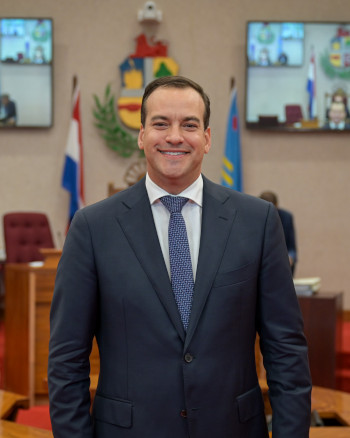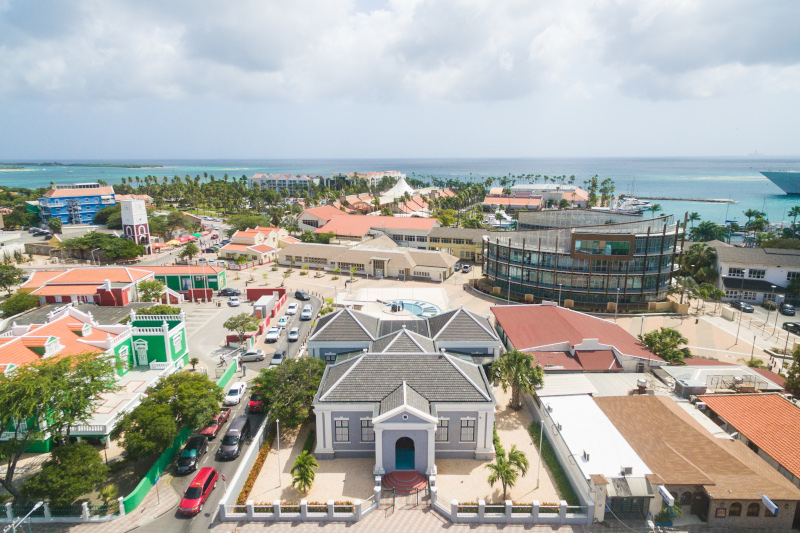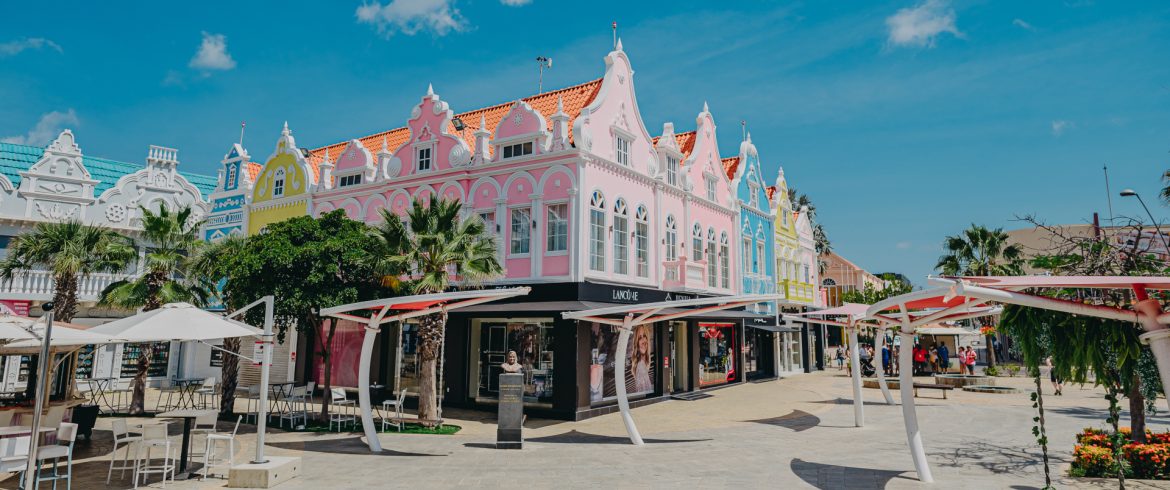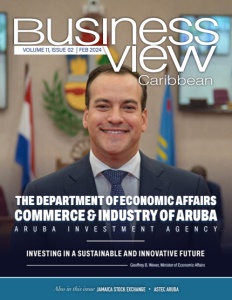The Department of Economic Affairs, Commerce and Industry of Aruba (The Aruba Investment Agency)
INVESTING WHERE IT MATTERS
PAVING THE PATH TO A SUSTAINABLE AND RESILIENT ECONOMY
Located at the southern edge of the Caribbean, you’ll discover the One Happy Island of Aruba, known for its beautiful blue waters, top-rated beaches, and lively culture. Aruba is highly regarded as a paradise to roughly 108,000 people who call it home and 1 million annual stayover visitors.
Although proximal to Latin America, Aruba shares strong cultural and political ties with the Netherlands and demonstrates proficiency in the languages English, Dutch, Spanish, and its native tongue, Papiamento. Beyond a sun-soaked destination, Aruba has a remarkable story of economic development and transformation that has made it a shining example of resilience and innovation in the region.
Aruba boasts several favorable macroeconomic indicators. Firstly, its GDP is anticipated to grow by 4.6% in 2024, an increase compared to the global average GDP growth forecast of 3.2%, as reported by the International Monetary Fund (IMF). The country has managed to mitigate large inflationary shocks and is projected to be at 2.3% in 2024, well below the expected global average inflation rate of 5.2%, safeguarding the purchasing power of Aruban residents. Moreover, Aruba’s fiscal position is robust, with a projected government budget deficit of 0.8% of GDP in 2023, indicating strong financial health and the ability to meet financial obligations. Lastly, the Aruban florin, Aruba’s currency, is pegged to the US dollar at a fixed exchange rate of 1.79 florins per US dollar, delivering stability and predictability for businesses and consumers.
From the gold rush of the 1800s to aloe cultivation in the 1890s, oil refining from the 1920s to 1985, and now a bustling tourism sector, the economic landscape of Aruba has undergone several transformations in its relatively short history. To this day, Aruba’s economy is heavily reliant on tourism, although the island’s historic industry of aloe cultivation continues to play a pivotal role in the economy. While the tourism industry has engendered significant wealth for the island, the Government of Aruba acknowledges that tourism alone is not conducive to a sustainable and resilient future.
In an era of rapidly changing circumstances and fierce global competition, Aruba has set a course to transform and empower its economy with a focus on sustainability and resilience. To this end, Aruba has committed itself to diversifying its economy by promoting foreign inward investment into the six promising sectors, harnessing the power of its abundant sunshine and consistent trade winds to fuel its energy revolution, and leveraging the transformative power of technology to digitize its economy to drive economic growth and enhance public services.
In 2020, the Government of Aruba instated the Aruba Investment Agency (ARINA) as part of its strategy to diversify the economy. Like other investment promotion agencies, ARINA is tasked with promoting international visibility of Aruba’s investment opportunities and facilitating the entry of impact investors that are committed to developing real economic activity within Aruba’s six promising sectors, as well as within the cities of Oranjestad and San Nicolas.
Attracting impact investors
The ambitious pursuit of impact investments is by no means a small feat, as this is often tied to the value proposition of the country. While Aruba’s market size is relatively small, it has an open, market-driven economy, an efficient legal system, an educated and multilingual workforce, and political stability. In fact, Aruba’s investment climate has ranked first place as the most attractive investment climate in the Caribbean for three consecutive years since 2021 according to the Caribbean Investment Climate Index.

Geoffrey B. Wever, Minister of Economic Affairs
Its value proposition towards investors is regionally strong and the Government continues to strengthen it through business-friendly policies and new economic developments. The Minister of Economic Affairs, Communication, and Sustainable Development, Mr. Geoffrey Wever, is committed to ensuring a red-carpet experience for investors willing to contribute to Aruba’s transformation for a stronger and better future.
The traditional image of doing business in the Caribbean is no more. Many still need to shake the outdated image of doing business by setting up a tin shack under some palm trees on a remote beach. This image no longer stands for modern-day Aruba. The Aruban economy is, now more than ever, filled with a myriad of profitable activities. From opportunities in agriculture to knowledge-intensive and circular economic activities, the diversification and sustainable and resilient development of Aruba is well underway. Aruba welcomes impact investors with the same warmth it did with its first tourists.
Embracing clean energy
Aruba’s dedication to clean energy is not just about reducing its carbon footprint; it’s also an economic strategy. Aruba aims to become energy-independent, ensuring a stable energy supply while reducing reliance on costly fossil fuels. With a focus on wind and solar power, Aruba is looking to increase its renewable energy share and engender economic growth in a clean and sustainable way.
Aruba scores high on the World Bank’s global ranking (#16) for conduciveness for photovoltaic installations. The abundance of sunlight makes it a logical and economical choice to opt for the installation of solar panels. Key initiatives in Aruba’s renewable energy journey include the installation of solar farms and encouraging homeowners and businesses to adopt solar panels. To make the energy transition inclusive for lower-income families, the Government of Aruba is looking into different policy interventions and incentives aimed at making these systems accessible.
Besides solar, Aruba’s strong trade winds make it conducive for wind energy generation. Currently, the only source of wind energy in Aruba is the Vader Piet wind farm which adorns Aruba’s south-eastern side with 10 wind turbines which produce approximately 15% of Aruba’s overall annual electricity demand. Aruba is looking to scale wind energy production by adding new, more efficient wind turbines with limited additional space.
Aruba is also making significant strides in slashing its fossil fuel use by using more efficient systems for energy generation. HFO use for energy generation has already declined by 31% since 2008 despite the growing population. This will further decline as WEB Aruba (Water and Electricity Company Aruba) transitions to LNG, rendering further energy efficiencies and reduced CO2 footprint. Furthermore, the introduction of new projects by WEB will yield greater efficiencies.

Digitalizing the economy
Aruba is still in the early stages of its digital transformation journey, but it has taken important steps in digitizing public services, simplifying bureaucratic processes, and reducing red tape. The Government of Aruba released the Aruba Digital Transformation Roadmap which outlines the government’s vision for its digital transformation. It includes several specific initiatives, such as developing a digital government platform, creating a digital identity system, and investing in digital skills development.
The e-government initiative offers citizens and businesses increasing access to a wide array of government services online, from requesting and renewing licenses to paying taxes. E-Government creates a pathway to unlock new economic value and opportunities created by the digital economy and aims to engender a seamless public sector experience.
San Nicolas and Oranjestad Development
San Nicolas, once a thriving industrial town, saw a drastic decline in economic activity and socio-economic well-being following the closure of the oil refinery. While San Nicolas is the island’s second-largest city (second to Oranjestad), its downtown has been barren for quite some time. Minister Geoffrey Wever has made it a top priority to revitalize the city.
The revitalization plan aims to generate substantial investments and stimulate entrepreneurship in the area with a special focus on developing San Nicolas into Aruba’s creative and cultural capital. Hand-in-hand with this are a number of projects geared at beautifying the area to create a vibrant and thriving urban environment. Besides expanding public spaces, upgrading public facilities, improving accessibility, and more parking opportunities, developing the cultural and creative industries will foster artistic and cultural activities that will contribute to the city’s unique identity.
Oranjestad won’t go untouched either. There is a revitalization plan for it as well to create a vibrant and inviting city center that offers more than just shopping opportunities. Emphasizing the city’s unique attributes, encouraging diverse economic activities, and improving livability are at the forefront of this initiative.
Plans include the construction of apartments and residential complexes to accommodate young professionals and students, as well as relocating government departments to the heart of the city to generate more foot traffic and economic spinoffs. Private investors are also recognizing the potential of beautifying the area. The restoration of ‘Pepe Margo House’ into an artisan Rum distillery serves as a prime example of rescuing Aruban heritage while providing a unique experience for both locals and tourists.
AT A GLANCE
The Aruba Investment Agency
What: A government organization dedicated to the economic vitality of the region
Where: Aruba, Caribbean Islands




 This information will never be shared to third parties
This information will never be shared to third parties